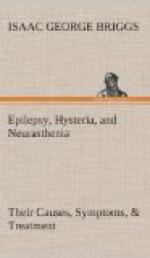Self-abuse may perhaps play some part in epilepsy commencing or recurring after the age of ten.
The onset of menstruation often coincides with the onset of epilepsy, and in some cases irregularity of the menses seems to be a secondary or exciting cause.
Exciting Causes aggravate the trouble when present, causing more frequent and severe seizures. The chief are irritation of stomach and bowels (from decaying teeth, unchewed, unsuitable, or indigestible food, constipation, or diarrhoea), exhaustion, work immediately after a meal, passion or excitement, fright, worry, mental work, alcoholism, sexual excess, nasal growths, eye-strain; in short, anything that irritates brain or body.
Theories as to Cause. Epilepsy is usually classed as a functional disorder; that is, the brain cells are physically normal, but, for some unknown reason, they act abnormally at certain times. This term is a very loose one, and there is reason to believe that the basis of epilepsy is some obscure disease of the brain which has not been detected by present methods.
The new school of psychologists regard the malady as a mental complex—a system of ideas strongly influenced by the emotions—the convulsions being but minor symptoms.
Fits are most frequent between 9-10 p.m. the hours of deepest repose. One school says this is due to anaemia of the brain during sleep. Clark traces the cause to lessened inhibitory powers owing to the higher brain centres being at rest, while Haig claims to have explained the high incidence at this hour by the fact that uric acid is present in the system in the greatest amount at this time.
Some doctors have thought, on the contrary, that excess of blood in the head was the cause, but results of treatment so directed did not bear out the sanguine hopes built on the theory.
The fact that convulsions occur in diabetes and alcoholism, suggested that epilepsy was due to poisons circulating in the blood, and thus irritating the brain. Every act uses up cell material and leaves waste products, exactly as the production of steam uses up coal and leaves ashes. Various waste products have been found in more than normal quantities in the blood of epileptics, but it is uncertain whether accumulation of waste products causes the seizure.
A convincing theory must satisfactorily account for all the widely diverse phenomena seen in epilepsy, and the problem must remain largely a matter of speculation, until research work has given us a far deeper insight into the biochemistry of both the brain cells, and the germ-plasm than we have at present.
* * * * *
CHAPTER V
PREVENTION OF ATTACKS
In health matters, prevention is nine points of the law.




